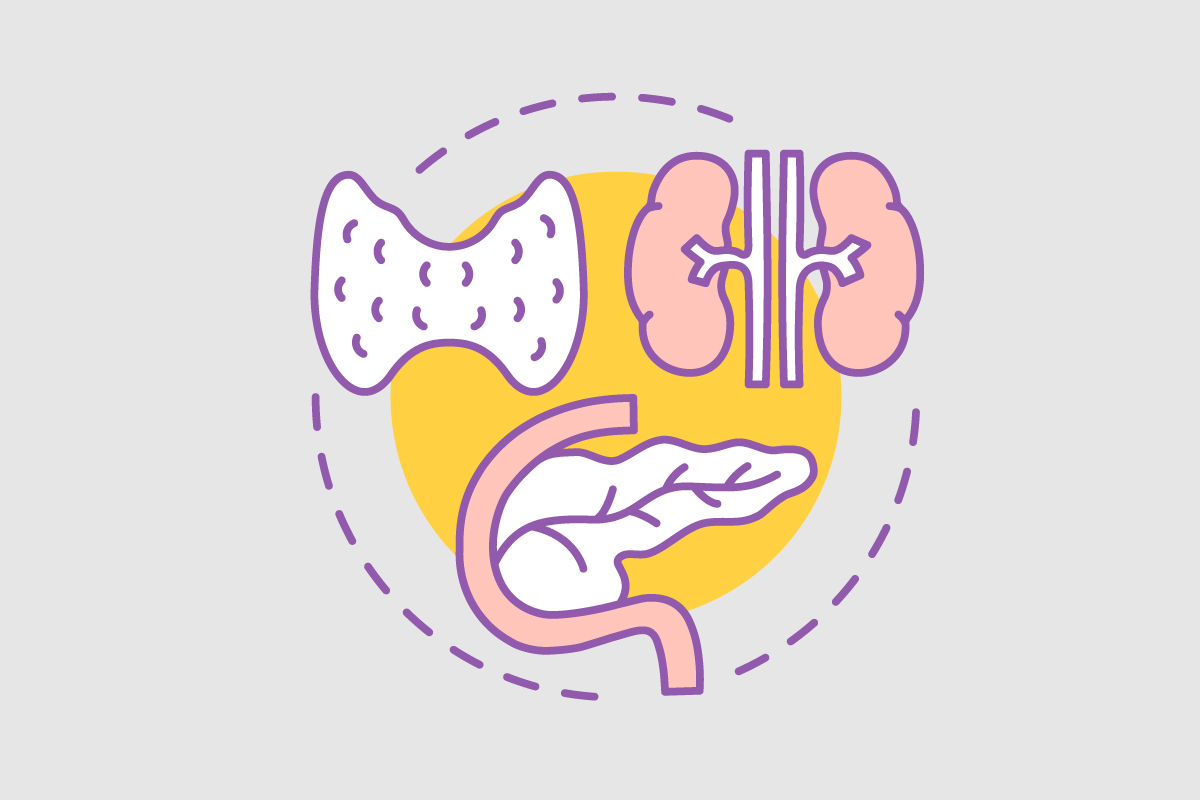Sleep, growth, mood, reproduction — glands help our bodies manage all of these activities. They also regulate metabolism, energy and sexual function, though many of us are unfamiliar with what each gland does.
“The endocrine system is made up of glands that produce hormones — adrenaline, testosterone — as well as organs that can act as glands, such as the pancreas,” says Dr. Daniel Cusator, a medical director for BlueCross BlueShield of Tennessee. “Other glands make up the exocrine system, and they produce substances such as oil, sweat or saliva.”
An easy way to remember which system does what:
- ENdocrine glands and organs produce hormones that ENter the bloodstream and stay IN the body.
- EXocrine glands produce hormones or substances that EXit the body through EXcretion.
Here’s a breakdown of how 15 common glands function in the body.
I. Endocrine system
Glands
Pituitary gland
Location: Below the brain, about the size of a pea
Function: Known as the endocrine system’s “master gland,” the pituitary uses information from the brain and other circulating chemicals to tell other glands what to do. It makes hormones that regulate growth, control skin pigmentation and stop dehydration. The pituitary also helps men produce testosterone and helps women breastfeed and produce estrogen.
Hypothalamus
Location: Base of the brain
Function: The hypothalamus can be considered the coordinating center of the endocrine system. Its biggest job is telling your pituitary gland to start or stop making hormones, but it also helps control water, sleep, body temperature, appetite and blood pressure.
Adrenal glands (2)
Location: Top of each kidney
Function: Adrenal glands produce hormones that maintain blood pressure and regulate metabolism. They also produce adrenaline, which regulates the body’s response to stressful situations (fight or flight).
Thyroid
Location: Low on the front of the neck
Function: The thyroid controls metabolism, heart rate and energy. If your thyroid doesn’t produce enough thyroid hormone (hypothyroidism), your system slows down, which can cause a slow heart rate, constipation and weight gain. Conversely, if it makes too much thyroid hormone (hyperthyroidism), everything speeds up, causing diarrhea, weight loss or increased heart rate.
Parathyroid (4)
Location: Behind the thyroid
Function: These small glands control calcium and phosphorus levels, which aid bone health.
Pineal gland
Location: Brain
Function: The pineal gland regulates sexual maturity and female reproduction. It also makes melatonin, which helps your body go to sleep. The pineal gland is larger before puberty, when humans have higher levels of melatonin.
Guide to natural sleep aids: chamomile, melatonin & more
Thymus
Location: Upper chest
Function: The thymus produces white blood cells that fight infections and abnormal cells. It is crucial to a child’s immune system development and, like the pineal gland, shrinks after puberty.
Organs
These organs contain endocrine tissue and act as glands.
Pancreas
Location: Back of the abdomen, behind the stomach
Function: As part of both the endocrine and digestive systems, the pancreas makes enzymes that break down food and also produces insulin (the hormone that regulates blood sugar). If your body doesn’t make insulin — or doesn’t make enough — that can cause diabetes.
Ovary (2)
Location: Both sides of the uterus
Function: Ovaries contain the eggs necessary for reproduction. They produce hormones (estrogen, progesterone) that help with breast development, regulate periods and support pregnancy.
Teste (2)
Location: Pouch outside the body, behind the penis
Function: Testes produce testosterone, a hormone that helps men grow facial and body hair during puberty, regulates penis growth and plays a role in making sperm.
II. Exocrine system
Lacrimal (2)
Location: Eye
Function: Lacrimal glands produce fluid that cleans, nourishes and lubricates eyes. When produced in excess, lacrimal fluid is known as “tears,” which is why these are often called “tear glands.”
Mammary (2)
Location: Breasts
Function: Mammary glands are a type of sweat gland that controls the production of breastmilk.
Salivary (6)
Location: In your mouth; Under your tongue (2), below your jaw (2), and in front of and just below each ear (2)
Function: Salivary glands produce saliva, a liquid that helps you chew, swallow, and digest food. Saliva also uses antibodies to kill germs and keep your mouth healthy.
Sebaceous (2,500+)
Location: All over the body, except for your palms and the soles of your feet
Function: Your body has 2,500-6,000 sebaceous glands per square inch. Also known as oil glands, sebaceous glands help skin retain moisture and fight infection. They also work with sweat glands to regulate body temperature.
Sweat (1.5 million+)
Location: All over the body
Function: Sweat glands keep your core body temperature close to 98.6 degrees by releasing sweat in hot environments or during physical activity.
There are 2 types of sweat gland:
- Eccrine glands cover most of your body and open directly onto the surface of skin.
- Apocrine glands open into the hair follicle. They are most common in your scalp, armpits and groin, as well as on eyelids and in the nose and ears. Apocrine glands secrete the milky fluid we recognize as “sweat” in a stress response.
On average, an adult’s skin is covered in 1.5 to 5 million sweat glands, with the highest density occurring in the palms and soles of the feet.
More from Dr. Cusator on WellTuned:
Get more information about specific health terms, topics and conditions to better manage your health on bcbst.com. BlueCross BlueShield of Tennessee members can access wellness-related discounts on fitness products, gym memberships, healthy eating and more through Blue365®. BCBST members can also find tools and resources to help improve health and well-being by logging into BlueAccess and going to the Managing Your Health tab.


